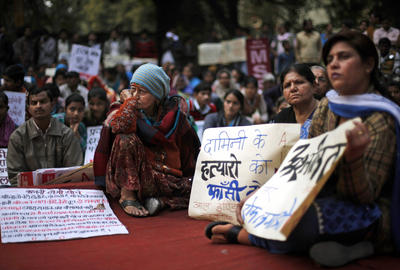The crime has come as a shock to Indian leaders. The masses, spanning four generations, have started discussing misogyny, barbarism, the influence of pornography in valorising sadomasochistic relations between men and women, the influence of Westernisation on women’s dress codes, consumerist culture, hedonism, and how the chivalry toward women that existed among civilized cultures is being replaced by hostility toward women. And the educated middle class that had previously declared India to be ‘post-feminist’ has suddenly started approaching ageing feminists, who have consistently sought to end violence against women, to be panellists and speakers at public forums.
Lively debates in media have scrutinised men as ‘hunters’ and women as ‘prey’. Patriarchal social structures have also been accused of helping to control women’s sexuality, fertility and labour through the weapon of rape or the fear of workplace sexual harassment; through double standards in sexual morality for men and women; and through the propensity of conservative forces, particularly religious leaders, to blame the victims of sexual assault.
In the past month, thousands of demonstrations throughout the country have demanded greater dignity, equality, autonomy and rights for women and girls. Protestors have demanded immediate relief through legal, medical, financial and psychological assistance, as well as long-term rehabilitation measures that must be provided to survivors of sexual assault. Improved infrastructure is required to make cities safer for women, including well-lit pavements and bus stops, help lines, and emergency services. Effective registration, monitoring and regulation of transport services (whether public, private or contractual) is needed to make them safe, accessible and available to all.
More broadly, demonstrators have called for compulsory courses on gender sensitisation for all personnel employed and engaged by the state in its various institutions, including the police. Demonstrators have also demanded that the police do their duty to ensure that public spaces are free from harassment, molestation and assault. This means the police force itself has to stop sexually assaulting women who come to make complaints. They must register all first information reports — an initial written document recording the offence — and attend to complaints. CCTV cameras should also be set up in all police stations and swift action must be taken against errant police personnel. Fast-track courts for rape and other forms of sexual violence need to be set up across the country immediately. State governments should prioritise the creation of such courts in areas where they are most needed and sentencing should be completed within a six-month period.
Demonstrators have also recognised that the National Commission for Women (NCW) has time and again proved itself to be an institution that works against the interests of women. The NCW’s inability to fulfil its mandate of eradicating violence against women, the problematic nature of statements blaming victims ‘for being out on the road at night’made by the chairperson, and its sheer inertia in many serious situations warrants a review and audit of the NCW as soon as possible.
The Indian state acknowledges the reality of custodial violence against women in many parts of the country, especially in Kashmir, the northeast and Chhattisgarh. There are several pending cases involving state custodians such as police, para military and military forces, and immediate action should be taken by the government to punish the guilty and to ensure that such incidents are not allowed to be repeated. Long-standing demands by women’s rights activists to reform India’s Evidence Act and section 376 concerning rape have also forced the government to form the Justice Verma Committee, which will provide recommendations on how to amend laws to provide speedier justice and appropriate punishment in sexual assault cases.
Thousands of individuals and groups have made online submissions asking for a comprehensive law that prohibits sexual violence, while ensuring an efficient criminal justice system. There is a broad understanding that any such law should focus on more than just penetrative sexual assault, as proposed in the Criminal Law Amendment Act. It is imperative that the definition of sexual assault is broad enough to include anal, oral and digital rape, as well as rape with objects, marital rape and sexual assault against transgender people. Currently, India is divided over demands such as ‘chemical castration’ and capital punishment for rapists.
In the demonstrations, rallies and public statements responding to this latest outrage, women have demanded freedom from fear. For the first time, the state is ready to accept the painful fact that there is widespread child sexual abuse in Indian society and an overabundance of sexual violence against women. This has given a big push to the ‘One Billion Rising’ campaign, which started on 25 November 2012 (the International Day for the Elimination of Violence against Women) and which will conclude on 14 February 2013. But the Indian state will have to struggle far beyond this date to achieve safety for women across the country.
Dr Vibhuti Patel is professor and head of the Department of Economics and director of the Department of Postgraduate Studies and Research, SNDT Women’s University, Mumbai.

